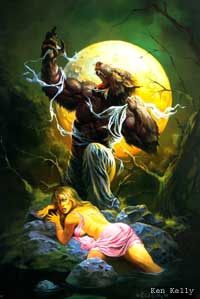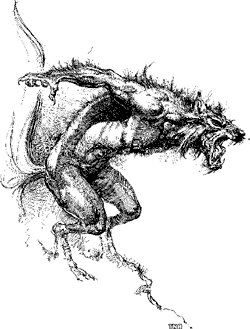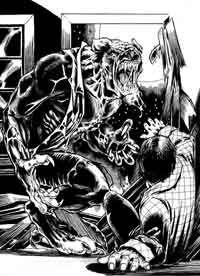Man-Wolf Shapeshifting Beings
In the early spring of 1971, residents of a Mobile, Alabama, neighborhood claimed to have had nocturnal encounters with an extraordinary creature. "The top half was a woman," one witness said, "and the bottom was a wolf." The witness added, unnecessarily, "It didn't seem natural." Such reports, which the Mobile police investigated with inconclusive results, are modern echoes of ancient beliefs about werewolves-human beings apparently able to transform themselves partially or wholly into wolves. The first half of the name comes from the Teutonic wer, meaning "man"; thus a werewolf is a man-wolf.
Such reports, which the Mobile police investigated with inconclusive results, are modern echoes of ancient beliefs about werewolves-human beings apparently able to transform themselves partially or wholly into wolves. The first half of the name comes from the Teutonic wer, meaning "man"; thus a werewolf is a man-wolf.Though known to most of us simply as a scary monster in horror movies and novels, the werewolf once was feared as a real-life menace. The first known use of the word in print goes back to the eleventh century, but a werewolf story survives from the first-century Satyricon. Beyond that, lycanthropy figures in Greek mythology, where Zeus, furious when he learns that Lykaon has served him and other gods human flesh, turns Lykaon into a wolf. Inspired by this myth, a cult took root in Arcadia. An initiate committed human sacrifice, an act that made him a "wolf" for nine years. Other scattered references in ancient writings testify to early fascination with man-wolves.
Origins
Historians, folklorists, and psychiatrists have offered various theories about the origin of the nearly universal belief in lycanthropy, the human-animal transformation that includes not only wolves but bears, big cats, hyenas, and other fierce creatures.Of all of these the werewolf is best known, at least in the West, no doubt because the wolf was the predator most feared by Europeans. Medieval and later chronicles tell of attacks by wolves on human beings (see Beast of Gevaudan), usually during wars and hard winters. Though zoologists today attest to the wolf's harmlessness to hurrianity (the harm, in fact, is entirely in the other direction), folklorists W.M.S. Russell and Claire Russell argue that "it is difficult to believe that all the past accounts, often highly circumstantial, are legendary." Moreover, "modern wolves have had many generations' experience of fire-arms, and are likely to be more cautious than their ancestors." The relationship between werewolf lore and rapacious wolves is made explicit in fifteenth- to eighteenth-century books on hunting; here a wolf that has developed a taste for human flesh is called a werewolf or (in French) loup-garou.
In northern Europe, wolfmen or berserkers -warriors clad in suits made of wolf skin-were notoriously murderous and deeply feared. At the same time, however, in Germany it was believed that after death, honored ancestors became wolves. Their descendants were sometimes given names such as Wolfhard, Wolfbrand, and Wolfgang on the theory that thereby wolf spirits would enter them and afford them strength and courage. In the Baltic and Slavic regions of Europe, people worshipped a wolf deity of uncertain temperament; it could protect, but it could also turn on the faithful without warning. As Christianity rose to power, the priesthood condemned such pagan beliefs as Satanic.
 As a consequence werewolves came to be seen as the devil's agents. Theological writers debated whether humans literally turned into wolves or simply were perceived as wolves by those whom Satan had deluded. Consensus held forth for the latter, on the grounds that only God, whose powers are greater than the devil's, could effect a physical change of species. In the words of St. Augustine:
As a consequence werewolves came to be seen as the devil's agents. Theological writers debated whether humans literally turned into wolves or simply were perceived as wolves by those whom Satan had deluded. Consensus held forth for the latter, on the grounds that only God, whose powers are greater than the devil's, could effect a physical change of species. In the words of St. Augustine:It is very generally believed that by certain witches' spells and the power of the Devil men may be changed into wolves . . . but they do not lose their human reason and understanding, nor are their minds made the intelligence of a mere beast. Now this must be understood in this way: namely, that the Devil creates no new nature, but that he is able to make something appear to be which in reality is not. For by no spell nor evil power can the mind, nay, not even the body corporeally, be changed into the material limbs and features of any animal . . . but a man is fantastically and by illusion metamorphosed into an animal, albeit he to himself seems to be a quadruped.
Persons who believed themselves to be werewolves testified, both under torture and otherwise, that they rubbed themselves with a salve before undergoing the transformation. The salve contained hallucination-inducing plants such as henbane and deadly nightshade. An interesting though in some ways unbelievable mid-eighteenth-century French account tells of a woman on trial as a suspected werewolf. Promised leniency if she would reveal her secrets, she had a pot of salve delivered from her house. After rubbing the substance on her head, neck, and shoulders, she lapsed into a three-hour coma. When she revived, she said she had turned into a wolf and in that condition killed a cow and a sheep. Investigators dispatched to the site found the animals' remains in the designated place.
The salve here is the "witches' salve," which they used to cover themselves before flying off to Sabbats. During the witch trials of the Renaissance period many writers, noting the salve's hallucinogenic effects, concluded that both Sabbats and human-wolf transformations occurred only in druginflamed imaginations. Others noted the role of mental illness ("melancholy"), sometimes aided and abetted by the devil's ability to confuse perception, in causing deluded individuals to believe they could turn into wolves or to think they had seen others doing so.
Werewolfery also was associated with persons we today would deem murderously mentally ill. Among the most notorious of these serial killer's was Stubbe Peeter, who was tried in Germany in 1589 for 25 years of hideous crimes, including murder of adults and children (including his own son), cannibalism, incest, and attacks on animals. Peeter claimed to have made a pact with Satan, who provided him with a girdle which turned him into a wolf. Nine years later French authorities arrested Jacques Roulet, a beggar, after they found him crouched in a bush and covered with blood from the badly mutilated nearby body of a 15-year-old boy. In his confession Roulet said he had slain the youth while a werewolf, a state he entered via the application of ointment.
Modern psychiatric literature documents the survival of lycanthropy as a serious mental disorder. At least one case (described in the November 1975 issue of the Canadian Psyciiiatric Association journal) had its origins in an LSD trip which an American soldier took in a European forest-a psychic and geographic echo of hallucinogens and werewolves past. Generally, according to psychiatrists Frida G. Surawicz and Richard Banta, lycanthropy is a "severe type of depersonalization" which may be triggered by drug abuse, paranoid schizophrenia, brain damage, or other causes. Psychoanalyst Nandor Fodor wrote that the "origin of 'Iycanthropy' cannot be traced to a point in historic time or to particular civilizations. It is in the human psyche, in human experience, that the 'Iycanthropic' fantasy is born.... In our dream life, the old, savage, lycanthropic beliefs are active conditions. They can be exploited, functionally, for criminal motives, while symbolically, the transformation represents self-denunciation for secret deeds or desires." Jungian psychologist Robert Eisler theorized that an archetype of the wolf, representing nature at its animal fiercest, lies deep in the collective unconscious, surviving as a kind of racial memory from a time when eariy human beings were hunter-killers. Under some circumstances such archetypal material may rise up to overwhelm consciousness and plunge the individual into a pathological identification with the wolf.
Sightings
Werewolves are found not only in mythology, folklore, and popular culture but in sighting reports as well. There are, however, relatively few of these. Of course, this is exactly what we would expect if werewolves-that is, man-wolves- -do not exist, as every sensible person assumes. On the other hand, most of what we know about the werewolf tradition is filtered through the writings of anthropologists and folklorists; they, being sensible people, ignored sighting reports from native informants or perhaps never thought to ask about them, on the assumption that since werewolves do not exist, no one could have seen one.Still, werewolves are only marginally less improbable than other things people see or think they see, as many other entries in this book attest. In short, we ought not to be too surprised at sighting reports, which are real enough even if werewolves are not. Yet most of the sightings are poorly documented, and those that come from apparently credible witnesses may be subject to other interpretations, albeit perhaps not in every instance one that will please those determined to link each oddity of human testimony to a comfortingly conventional stimulus. In any case, if the stories that follow do not amount to a case for real-life man-wolves, they are nonetheless worth noting, and they are undeniably interesting.
In a 1960 issue of Fate, Mrs. Delburt Gregg of Greggton, Texas, told of an encounter with a shapeshifting creature. Such reports are exceedingly rare in modern times. The other sightings surveyed below are simply of creatures that looked like manwolves; nobody claims to have seen one becoming another. Mrs. Gregg does not make such a claim either, but she comes closer than anyone else in a tale that sounds more like an early chapter from a werewolf novel than a real-life experience.
As her story goes, one night in July 1958 while her husband was away on business, Mrs. Gregg moved her bed close to a screened window hoping to catch the cool breeze from a thunderstorm brewing on the southwestern horizon. She had dozed off only a short time before she heard a scratching sound on the screen. In a flash of lightning she saw a "huge, shaggy, wolflike creature ... clawing at the screen and glaring at me with baleful, glowing, slitted eyes. I could see its bared white fangs."
She leaped from bed and grabbed a flashlight as the creature fled through the yard and into a clump of bushes. "I watched for the animal to come out of the bushes," she wrote, "but, after a short time, instead of a great shaggy wolf running out, the figure of an extremely tall man suddenly parted the thick foliage and walked hurriedly down the road, disappearing into the darkness."
 More characteristic of modern American werewolf stories are those told between July and October 1972 by a number of residents of Ohio. They reported seeing a six- to eight-foot-tall creature which one witness described as "human, with an oversized, wolflike head, and an elongated nose." Another said it "had huge, hairy feet, fangs, and it ran from side to side, like a caveman in the movies." It also had glowing red eyes. During the early morning hours it allegedly sneaked up behind a trainman working along the tracks in downtown Defiance and whacked him with a two-by-four. Presumably we have here a prankster or a madman dressed to care.
More characteristic of modern American werewolf stories are those told between July and October 1972 by a number of residents of Ohio. They reported seeing a six- to eight-foot-tall creature which one witness described as "human, with an oversized, wolflike head, and an elongated nose." Another said it "had huge, hairy feet, fangs, and it ran from side to side, like a caveman in the movies." It also had glowing red eyes. During the early morning hours it allegedly sneaked up behind a trainman working along the tracks in downtown Defiance and whacked him with a two-by-four. Presumably we have here a prankster or a madman dressed to care.Four Gallup, New Mexico, youths allegedly encountered what they called a "werewolf" along the side of a road near Whitewater one day in January 1970. It managed to pace with their car, which was traveling at 45 miles per hour. One witness reported, "It was about five feet seven, and I was surprised it could go so fast. At first I thought my friends were playing a joke on me, but when I found out they weren't, I was scared! We rolled up the windows real fast and locked the doors of the car. I started driving faster, about 60, but it was hard because that highway has a lot of sharp turns. Someone finally got a gun out and shot it. I know it got hit and it fell down, but there was no blood. I know it couldn't be a person because people cannot move that fast."
This sounds like a "skin-walker," the name the Navahos of the Southwest give to the werewolf. In 1936, in Yale Publications in Anthropology, anthropologist William Morgan recounted an interview with a Navaho identified only as Hahago. Hahago said of skin-walkers, "They go very fast.... They can go to Albuquerque in an hour and a half--a four-hour trip by automobile, according to Morgan.
In the fall of 1973 western Pennsylvania played host to dozens of reports of strange apelike creatures, sometimes seen in association with UFOs, said to have (in one witness's words) "fire red eyes that glowed in total darkness," to be seven to eight feet tall, and to give off a strong, unpleasant odor. "Another type of creature," investigator Stan Gordon noted, "was said to be between five and six feet tall. It was described as looking just like an extremely muscular man with a covering of thick dark hair. Again in these reports, the arms were very long and hung down past the knees. This creature appeared to have superior agility exceeding that of a deer. From footprints discovered, the stride of the creatures varies between 52 and 57 inches. In these reports there was no indication of odors." Two sketches published in Flying Saucer Review (July 1974, page 5) show these creatures to bear a striking resemblance to the traditional werewolf, though neither witnesses nor investigators remarked on the fact.
If these stories are not outright hoaxes, they clearly indicate the presence of extraordinary, otherworldly creatures which challenge consensus views of reality. On the other hand, in some cases it is possible both to believe the witnesses and to keep one's ties to reality intact. In the Delphos, Kansas, area during July 1974, for example, several persons encountered what a newspaper described as a "young child about 10 or 12 years old, with blood, matted hair, dressed in tattered clothing, running through vines and brush in a wooded area in the northwest edge of Delphos." She was dubbed the "wolf girl." Though local authorities never found her, she may well have existed, probably as a mentally retarded runaway or abandoned child.
Some medically educated theorists have suggested that sightings of werewolves really were of individuals afflicted with a rare genetic disease called porphyria. Porphyria sufferers experience tissue destruction in the face and fingers, skin lesions, and severe photosensitivity. Their facial skin may take on a brown pigmentation, and they may fall victim to personality disorders. The aversion to light, plus the physical disfigurement, may lead the victim to wander about only at night. "These features," British neurologist L. Illis wrote in a 1964 issue of Proceedings of the Royal Society of Medicine, "fit well with the description, in older literature, of werewolves."

